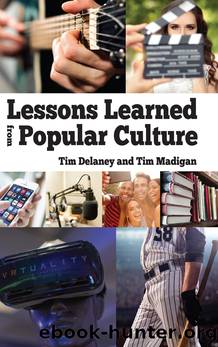Lessons Learned from Popular Culture by Tim Delaney Tim Madigan

Author:Tim Delaney, Tim Madigan [Tim Delaney, Tim Madigan]
Language: eng
Format: epub
Tags: Social Science, Popular Culture, Media Studies, Performing Arts, Film, History & Criticism
ISBN: 9781438461472
Google: Dc2MDAAAQBAJ
Publisher: SUNY Press
Published: 2016-06-28T05:17:22+00:00
Dr. Seuss on the Loose
Even though he died in 1991, in 2014 Theodor Seuss Geisel astonished the publishing world with a ânewâ collection of stories. Better known to the world as the beloved childrenâs book author known as Dr. Seuss, Geisel (1904â1991) was both a master of rhyme and a talented artist. His 2014 Horton and the Kuggerbug and More Lost Stories was not in fact a ânewâ book at all, but rather a collection of previously published but long forgotten works that had appeared originally in Redbook magazine in the 1950s. Geiselâs biographer Charles Cohen had discovered these pieces, dealing with some of Dr. Seussâs most famous characters and placesâHorton the Elephant, the Christmas-hating Grinch, and Mulberry Street, as well as newly discovered characters such as the Kuggerbug, a mean little creature who loves to tap dance on Hortonâs nose. âThe stories,â Philip Sherwell writes, âfeature his distinctive free-flowing rhyme in its anapaestic tetrameter. âHe climbed and he climbed and he clum and he clum,â he writes of one character, displaying his playful use of tenses and languageâ (Sherwell 2014).
A gifted cartoonist as well, Seussâs poetic skills were legendaryâhe had the ability to use simple rhymes that nonetheless stayed permanently in oneâs head. Millions of people have had the experience of reading one of his classic works, such as The Cat in the Hat, Horton Hears a Who, or Green Eggs and Ham when they were children and still remember them by heart decades later. And most parents have had the pleasure of reading these stories again, this time to their own children (and grandchildren).
As Amy Graff points out, âSeuss has been delighting children with his extraordinary imagination, made-up words, zany characters and silly rhymes ever since publishing And to Think That I Saw It on Mulberry Street in 1937. The release of this book was a miracle of sorts as the manuscript was rejected by 27 publishersâ (Graff 2014). Just when he was about to give up, a former college classmate who had gotten a job as a childrenâs book editor saved the day. And the rest is history.
While he eventually wrote almost fifty books for children, many people do not know that this was not Theodor Geiselâs original vocation. He began his career as a commercial illustrator (creating such memorable ads as âQuick Henry, the Flit!â for a brand of insect repellant, which became a national catchword) and a political cartoonist. During the Depression era he created many political cartoons for the liberal New York newspaper PM, most of which attemptedâin as humorous a way as possible, given the subject matterâto alert Americans to the growing danger of Adolf Hitler and Nazism, and encourage them to begin preparing for eventual war against the fascist powers. This advocacy of preparedness went against the Isolationism that predominated in America at the time. Having only recently experienced the horrors of World War I, most Americans were in no mood to contemplate going to war again, and manyâincluding such stalwart figures
Download
This site does not store any files on its server. We only index and link to content provided by other sites. Please contact the content providers to delete copyright contents if any and email us, we'll remove relevant links or contents immediately.
| Direction & Production | Genres |
| Guides & Reviews | History & Criticism |
| Reference | Screenwriting |
| Shows |
Robin by Dave Itzkoff(2415)
Head of Drama by Sydney Newman(2275)
I'm Judging You by Luvvie Ajayi(2179)
The Paranormal 13 (13 free books featuring witches, vampires, werewolves, mermaids, psychics, Loki, time travel and more!) by unknow(2071)
Ten by Gretchen McNeil(1859)
Single State of Mind by Andi Dorfman(1795)
#MurderTrending by Gretchen McNeil(1639)
Key to the Sacred Pattern: The Untold Story of Rennes-le-Chateau by Henry Lincoln(1614)
Merv by Merv Griffin(1601)
Most Talkative by Andy Cohen(1572)
This Is Just My Face by Gabourey Sidibe(1452)
Notes from the Upside Down by Guy Adams(1452)
The Hunger Games: Official Illustrated Movie Companion by Egan Kate(1412)
Springfield Confidential by Mike Reiss(1394)
Binging with Babish by Andrew Rea(1377)
Jamie Oliver by Stafford Hildred(1376)
The TV Writer's Workbook: A Creative Approach To Television Scripts by Ellen Sandler(1330)
Clarkson--Look Who's Back by Gwen Russell(1328)
Blue Planet II by James Honeyborne & Mark Brownlow(1261)
